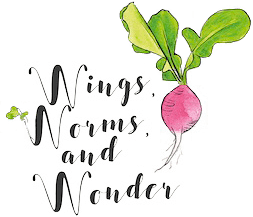Wonder Wednesday # 20 – Tree Tagging
Gardening and connecting with nature is often a doorway into community and place connections. Connection is one of the many things I love about gardening! It seems the more you connect with one thing, the more doors open for a world of different connections on our earthly web. So in that vein of an idea, I present you with The Tree Tag Project by Tinkerlab! Don’t worry! There is no spray paint involved and this type of tagging is totally legal!
I recently discovered this brilliant idea and knew I had to share it with you and your students!! While the originator did this in their own yard as a way to initiate neighborhood connection, which is awesome and totally recommended, try this in your schoolyard as a way to build school wide community between teachers, students, parents, staff, and administration.
(Photo credit: Tinkerlab)
“What is the Tree Tag Project?
Our neighbors are invited to write their response to a prompt and then hang it from a tree.
What’s the Point?
Bring people together: I want my children to get to know their neighbors outside of hosting the usual lemonade stand.
Empower a child: It’s empowering for children to see that they can set up a real world project that other people will respond to.
Be Surprising: Surprise my neighbors with an interactive project that stops them in their tracks and gets them thinking.
Democratize visual communication: Have you noticed that public visual communication is often limited to brands as they market to us through their loud signs and billboards. Visual noise is all around us, so why not reclaim a bit of this space in a way that’s fun, inexpensive, positive, and community-building?” (The Tree Tag Project)
I highly recommend reading the original Tinkerlab Blog “The Tree Tag Project” post. It is very clever and the pictures are fantastic! Then, check out Tinkerlab on Facebook
(Photo credit: Tinkerlab)
Wonder Wednesday # 20
Set up a Tree Tagging Station in your Schoolyard!
Adapted for the schoolyard from the Tinkerlab Blog’s “The Tree Tag Project” by Rachelle
Materials:
A small table, or other platform to use as a table like a larger stump
A basket or box to put the tag supplies in, if you plan to leave this outside all the time you may choose a plastic box with a sealing lid, if you are bringing it inside each afternoon a basket will work
Crayons or colored pencils
Paper craft tags or make your own from approximately 2×3 inch rectangles of any type of paper with a hole punched at one end. (You may want to use loose leaf reinforcers over the hole punch to strengthen the tag depending on how thick your paper is.)
4×5 cards for creating prompt questions
Pieces of yarn or string cut approximately 6 inches to create tag hangers
A prompt cards (You may want to laminate this for future use.)
Preparation:
Buy, or cut, and hole punch the tree tags. You may choose to reinforce the holes.
Cut the string lengths.
Create the prompt questions by writing one question on each prompt card. Consider questions that are interesting and applicable to the community with which you are connecting. Get the students involved in creating the questions. This could even be a writers workshop activity. You may choose to laminate these cards for future use. The Tinkerlab post begins with the question “What’s your favorite place to travel to…near or far?” Try questions such as: what’s your favorite…food, flower, book, season, subject, or color?; or how does sunshine or music make you feel?
Place the blank Tree Tag cards, a few crayons or colored pencils, and string pieces in the box or basket.
Place one prompt card in the box at a time.
Procedure:
Choose a highly visible spot that is easily accessible by all members of your school community and near a tree or other larger form of nature where tags can be hung, like a hedge or within your school garden.
Set up the small table with the basket of tree tagging supplies
Then, have your students create tree tags for each prompt first and hang them up to get it going within the community. You can even have your students visit other classes and introduce the project as public speaking and how-to practice. Younger students can draw and older students can write. Have the students put their first names and perhaps their age or grade level on the tags.
Have a rotating schedule of students that manage the tree tagging station. Each day during their rotation they will check the supply levels in the box and count the numbers of new tags and report back any responses that they find particularly interesting. Be sure to make time for the entire class to go out and explore and enjoy the tree tags as well.
Start connecting and see what happens! How will this project bring your classroom and school wide communities together? Do you know what your hard working custodian’s favorite food is or how about one of your student’s grandmother’s favorite colors? Do your students know how sunshine makes you feel? I bet not, but once the community starts to connect, everyone will understand how they fit into the web of life a little better!



